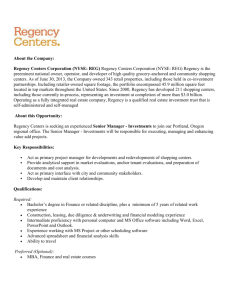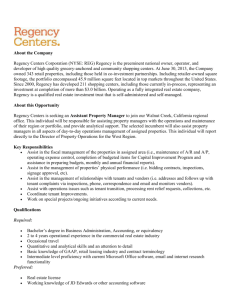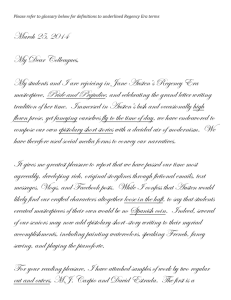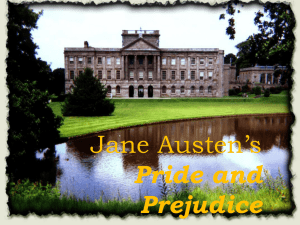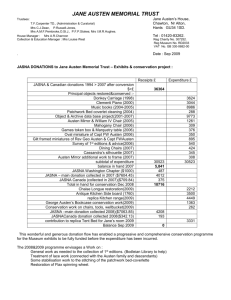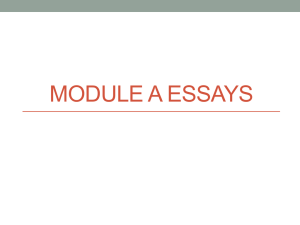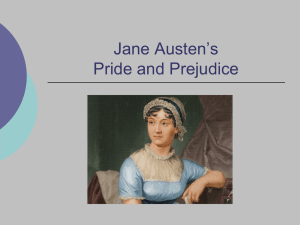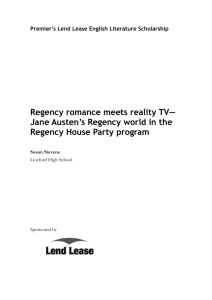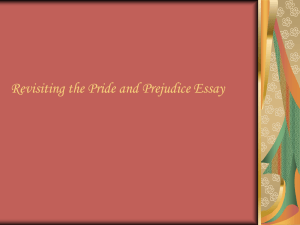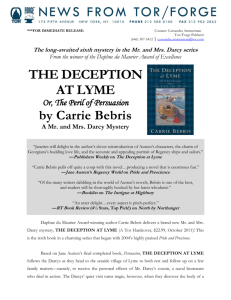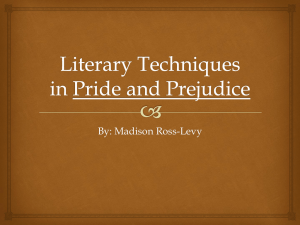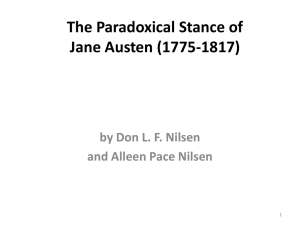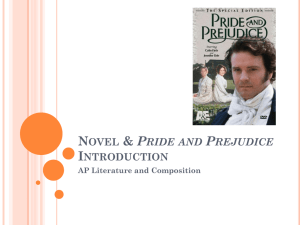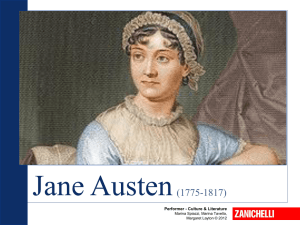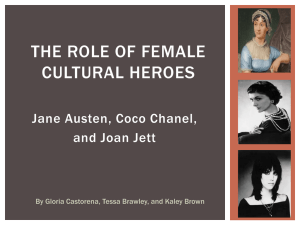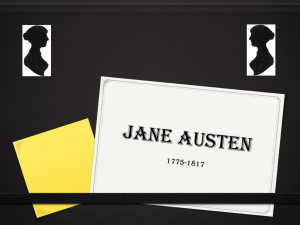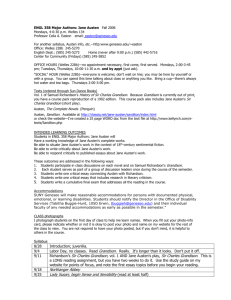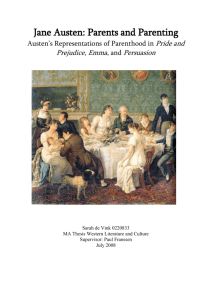Jane Austen and Her Time
advertisement
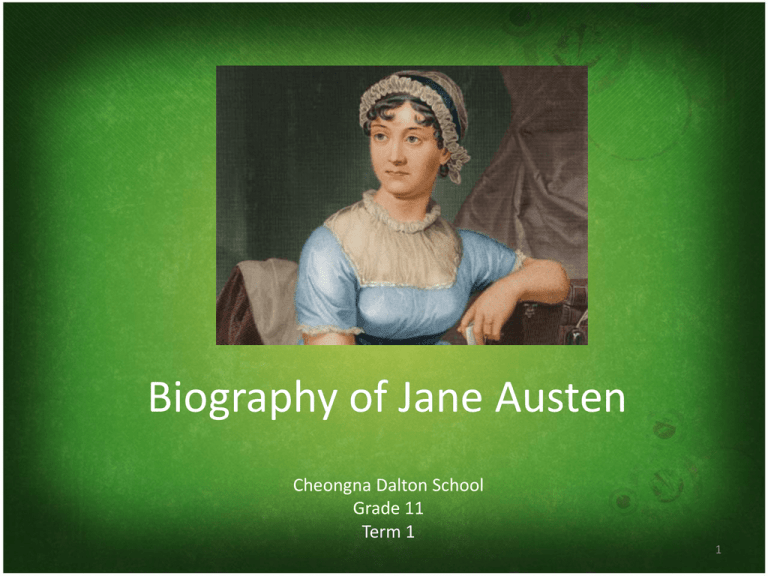
Biography of Jane Austen Cheongna Dalton School Grade 11 Term 1 1 • Jane Austen was born on 16th December 1775, at Steventon in Hampshire, where her father, the Rev. George Austen, was rector. • Her mother was Cassandra Leigh. • Jane Austen died on July 18th, 1817. 2 • The Austens were moderately well off. They kept a carriage and pair and ‘enjoyed … some of the considerations usually awarded to landed proprietors’. • The household was lively and bookish. • The family also enjoyed writing and performing plays for evening entertainment. 3 • When young she went to balls and picnics, and paid visits like any other girl of her class. • Once, it seems, she may have been seriously in love, but the man died. • She never married. 4 Great Britain in the Regency Era Austen Country Austen Rectory at Steventon 1775-1801 Steventon Church Chawton Cottage 1809-1817 Austen’s Will from the UK National Archives: http://www.nationalar chives.gov.uk/museum /item.asp?item_id=33 Jane Austen’s grave in Winchester Cathedral • This is a photograph of a coat worn by Jane Austen. • It gives an idea of the type of clothes worn by young ladies of the time. 10 Austen Novels • • • • • • Pride and Prejudice 1796 (Pub. 1813) Sense and Sensibility 1797 (Pub. 1811) Northhanger Abbey 1798 (Pub. 1818) Mansfield Park (Pub. 1814) Emma (Pub. 1815) Persuasion (Pub. 1818) 11 “Novels of Manners” • Novels dominated by the customs, manners, conventional behavior and habits of a particular social class • Often concerned with courtship and marriage • Realistic and sometimes satiric • Focus on domestic society rather than the larger world • Other novelists of manners: Anthony Trollope, Edith Wharton, F. Scott Fitzgerald, Margaret Drabble Jane Austen Quotes • “A lady's imagination is very rapid; it jumps from admiration to love, from love to matrimony in a moment.” • “A large income is the best recipe for happiness I ever heard of.” • “An engaged woman is always more agreeable than a disengaged. She is satisfied with herself. Her cares are over, and she feels that she may exert all her powers of pleasing without suspicion. All is safe with a lady engaged; no harm can be done.” 13 Simplicity of the Empire line dress Fluffy Hollywood! 14 The Regency Period Cheongna Dalton School Grade 11 Term 1 15 The Regency Period 1795-1830 (give or take a few years) The Regency Period • The Regency period in the United Kingdom is the period between 1811 and 1820, when King George III was deemed unfit to rule and his son, later George IV, was instated to be his proxy as Prince Regent. The term is often expanded to apply to the years between 1795 and 1837, a time characterised by distinctive fashions, politics and culture. In this sense, it can be considered to be a transitional period between "Georgian" and "Victorian" eras. The era was distinctive for its architecture, literature, fashions, and politics. 17 General Definition • The Prince Regent (later King George IV) ruled UK during the mental incapacity of his father King George III (he is the ruler who gave the American colonists a hard time). • A regent is someone appointed to rule instead of the King. • During this period, English middle class gained considerable prestige and social status due to the success of the Industrial Revolution. • Newly successful middle class began to associate with the landed aristocracy by purchasing extravagant estates. They were called the landed gentry. Rise of Industrialism • People moving from towns and farms to cities and factories • Shift from a primarily agrarian economy to an industrial economy • London first industrialized city in the world 19 British Power in the Regency Period • England embroiled in Napoleonic Wars Battle of Trafalgar Auguste Mayer, 1836 – 1803-1815 – 1805—Battle of Trafalgar – 1815—Battle of Waterloo • War of 1812 with U.S. • British Empire dominated India, the West Indies, and the Persian Gulf 20 21 The Class System • • • • All in Austen’s day were keenly aware of class Very little inter-class interaction Upper class frowned upon marrying “low” Estates passed along the male line – Bennet’s entail to Collins • Late 18th century: first time for wide-ranging upward mobility – Nouveau riche (newly rich): Bingley – People from middle classes start to make lots of money because of rising industrialism 22 Expectations for Upper and Upper-Middle Class Women • Could not express opinions openly • Submit to will of patriarch • Chaperoned when in the company of men • Could not own property • Young women could not leave the home without permission • Entertainers for men (music, singing, etc.) 23 Marriage in the Regency Period Women dependent on men for all expenditures Marriage only way to get out from under parent’s roof Women who did not marry were looked down upon socially No family inheritance and no marriage = destitution and poverty 24 The Economics of Marriage • “It is a truth universally acknowledged, that a single man in possession of a good fortune must be in want of a wife” (3) • For young men, social advancement lay in the military, church, or law • For women…successful marriage 25 Women’s Work in Early 19th Century • Did not work away from home – Could be a governess, though, but isolated and frowned upon • Did not work at home either – Mrs. Bennet takes pride in stating to Mr. Collins “that [the Bennets] were very well able to keep a good cook, and that her daughters had nothing to do in the kitchen”. • Some may have worked in the garden • Writing was not considered an appropriate profession 26 for women Education for Women • Expected to know how to sing and play an instrument • Expected to have private tutors or a governess • Education received at home, though there were some boarding schools – Learned French, dancing, music, and drawing • Universities only for men 27 Regency Entertainment/Leisure • • • • Card games Reading Gambling halls Lavish balls—dances of the era lively and bouncy • Dinner parties • London Theatre 28 Social Etiquette • Many social rules • Politeness and gentility – Women could not speak their minds – Mrs. Bennet not polite or genteel (114) • Protocols for everything – From introductions to the way a young woman holds her fan – Note how Collins introduces himself to Darcy • Social hierarchy ruled – Everyone knew his/her place 29 Georgian Era (1714-1811) Fashion Period prior to Regency Rich colors, often ostentatious; embroidered and raised fabrics Women: - heavy, ornate, restrictive corsets, fitted bodice, hoopskirt, floor-length skirt, white makeup, beauty mark, hair or wig sometimes worn high Men: - heavy and raised fabric coats, knee-length breeches, buckled shoes, white wigs 30 Georgian Era (18th Century) 31 More Georgian Era 32 Georgian Era 33 Regency Fashion Regardless of the wearer's social class, less ornate, and simpler than past decade Lighter fabrics Women waistline raised to below the chest, inspired by classical Greece flowing loose gowns long sleeved jackets cut beneath chest no more white makeup hair shorter or worn closer to the head Broad-brimmed bonnet worn with ribbon tied under chin Men: dark tailcoats white or flesh toned, full-length pants riding boots top hat and hair—short and natural 34 Regency Period Evening gown Day dress Outdoor dress 35 36 Regency Period 37

